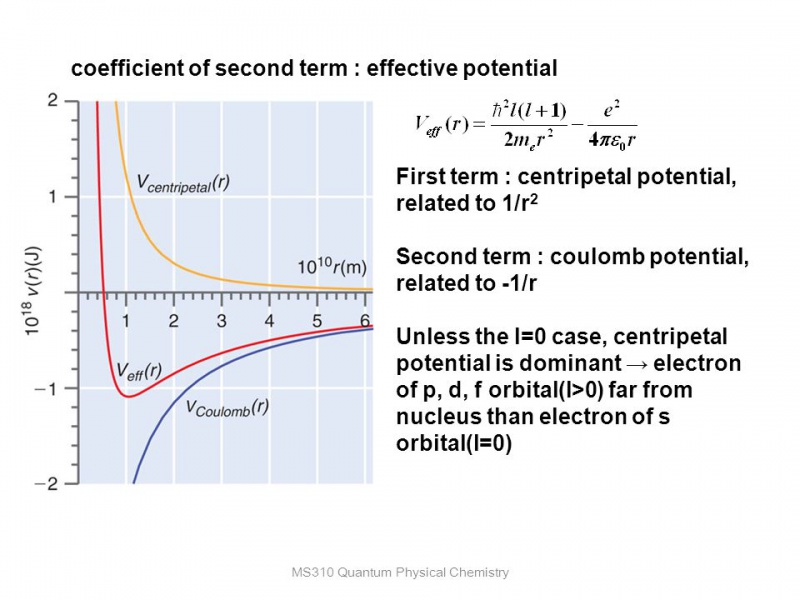PCh9 Lec 2
(4/8/20, bes)
Sorry...still working (or not working) on the exams.
Chapter 9: The Hydrogen Atom (cont...)
- ...focusing on Sec 9.1-9.3
As with most QM models the potential energy term makes the Hamiltonian more complex leading to a more complex solution/wavefunction. For the hydrogen atom, the potential energy term is the coulombic potential (Coulomb's law), an electrostatic attraction between the positive nucleus and the negative electron. Technically, Coulomb's law (classical mechanics) applies to stationary charges (+/-, +/+, -/-). Since the electron is moving around the nucleus (aka. the shell model), there is an additional force that is involved in this system. Figure 9.1 is one of the most important figures to understand in all of QM.
As you can see, there are two opposing forces:
- 1) Coulomb potential that is dependent on 1/r, and
- 2) the centripetal potential/force that is dependent on 1/r2.
Where did the centripetal force come from...???...see eq. 7.26, which is the solution to the 3D rotation model. So in solving this Schrodinger equation (eq. 9.2), we used the "separation of variables" strategy (sec 9.2) to solve first for the rotational energy, then took this solution (eq. 7.26) and restructured the Schrodinger equation (eq. 9.5). Now, we essentially start over again with this new Schrodinger equation with the potential term now being called the "effective potential energy," Veff and the wavefunction being a function of only r...R(r).
Mathematica...as i said, this is one of the most important concepts in QM. I have at this point in a lecture asked you to reproduce figure 9.1 using Mathematica. Please do so now and then send me the file via email (note the r scaling is from 0 --> 6e-10m). For those who do not have access to Mathematica, then please keep reading and then send me an email with a hand-drawn picture.
Returning to Figure 9.1 (play along in Mathematica if you have the plot), you will see the Veff function looks very similar to the Morse potential we discussed during the IR spectroscopy section (just a side note). In this figure the l=1 (p-orbital) and as a result, the Veff has a certain "well depth." Remember, the depth of the well is an indication of how "trapped/bound" the electron is under these conditions. If the value of l was changed to 2 (d-orbital), then you will notice (in Mathematica) that the well depth will decrease indicating that the electron in this state is less trapped/bound. If you increase l to 3 (f-orbitals) again you will notice that the well becomes very shallow and hence the f-orbital electrons are not very bound.
Please send a Mathematica file with Fig 9.1 reproduced, and also a plot (without the Coulombic and centripetal potential) with the Veff with l=1, Veff with l=2, Veff with l=3, and Veff with l=4. For those without access to Mathematica, please draw by hand the Veff (l=1, 2, 3, 4) plot; l=4 does not have a well....it looks more like Vcentripetal.
More on wavefunctions after Easter break...
Take home point: Introductory chemistry students often ask why (or i wish they would ask why) there are not more element in the periodic table...the answer should be clear from our discussion...for electrons that might exist in "higher orbitals" (l=4 or above) they would have too much centripetal repulsion and not enough Coulombic attraction to make them stable...get it!
End of Lecture 2.
